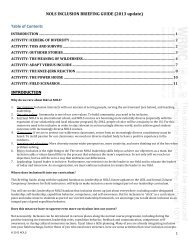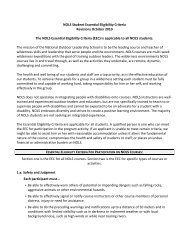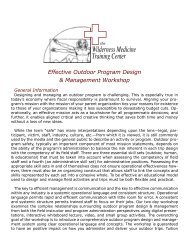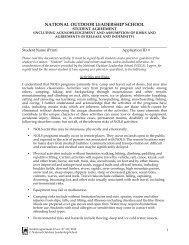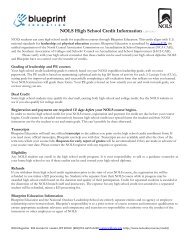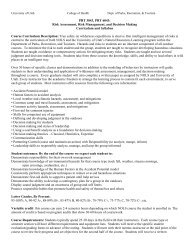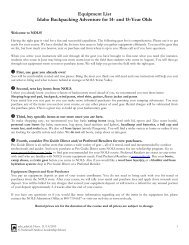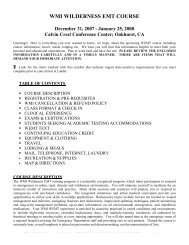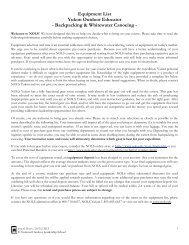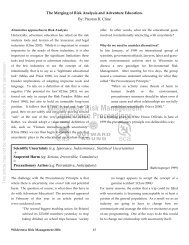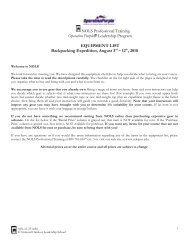introduction to the 2008 nols leadership educator notebook
introduction to the 2008 nols leadership educator notebook
introduction to the 2008 nols leadership educator notebook
Create successful ePaper yourself
Turn your PDF publications into a flip-book with our unique Google optimized e-Paper software.
CoachingConsider how best <strong>to</strong> coach your students. Everyone has <strong>the</strong>irown style. Will you wait <strong>to</strong> give feedback until <strong>the</strong> end of <strong>the</strong> day?How much should you interject while <strong>the</strong>y lead? How you coachyour students provides lessons just as valuable as <strong>the</strong> actual coachingyou offer. You don’t need <strong>to</strong> discuss <strong>the</strong> educational merits of yourcoaching; it’s enough that you model respectful habits. Much of acourse’s experience speaks for itself and doesn’t need <strong>to</strong> be reduced<strong>to</strong> words <strong>to</strong> be educational. Let your coaching be an example of oneway <strong>to</strong> teach experientially.Teachable MomentsAs instruc<strong>to</strong>rs become more fluent with <strong>the</strong> curriculum <strong>the</strong>y alsobecome more adept at finding natural teaching opportunities on anexpedition. Wea<strong>the</strong>r moves in, Plan A gets <strong>to</strong>ssed out <strong>the</strong> window,and <strong>the</strong> savvy instruc<strong>to</strong>r finds a minute <strong>to</strong> mention <strong>to</strong>lerance foradversity. There is almost always a <strong>leadership</strong> lesson hidden in <strong>the</strong>day’s events. It isn’t luck, it’s seeing <strong>the</strong> opportunities in change. Inthis example, if it was your course and you had just decided <strong>to</strong> backoff of a sea kayak paddle around a point, <strong>the</strong> discussion afterwardwould be <strong>the</strong> perfect opportunity <strong>to</strong> teach about situational <strong>leadership</strong>and decision-making in a set of circumstances that may nothave been relevant yet on your expedition.NOLS expeditions must be challenging enough that leaders,both student and instruc<strong>to</strong>r, practice dealing with dynamic systemsand applying <strong>the</strong>ir knowledge <strong>to</strong> new situations. Some <strong>leadership</strong>schools intentionally create conditions where leaders-in-trainingneed <strong>to</strong> make timely decisions with incomplete information. Onour expeditions <strong>the</strong>se situations literally come with <strong>the</strong> terri<strong>to</strong>ry.Our job is <strong>to</strong> finesse <strong>the</strong>se events, balancing student decision-makingopportunities with sound risk management practices.In stressful conditions, if a student leader doesn’t default <strong>to</strong> an appropriate<strong>leadership</strong> style, <strong>the</strong>n instruc<strong>to</strong>rs can recommend a quickand efficient approach. Once <strong>the</strong> LOD has made and implementeda plan, it is <strong>the</strong> perfect time <strong>to</strong> discuss it as part of <strong>the</strong> <strong>leadership</strong> curriculum—asclose as possible <strong>to</strong> still being “in <strong>the</strong> moment.” Later atcamp might be a good time <strong>to</strong> discuss <strong>the</strong> <strong>the</strong>oretical pros and consof different ways <strong>to</strong> make decisions in similar, future situations.Everything depends on how well <strong>the</strong> student leader is handling<strong>the</strong> situation and on how much <strong>the</strong> group can afford <strong>to</strong> flounder.Our aim is <strong>to</strong> prepare our students <strong>to</strong> succeed in critical situationsby <strong>the</strong>mselves.Integral EducationIt can take a new instruc<strong>to</strong>r dozens of field weeks of apprenticing<strong>to</strong> competently teach single <strong>leadership</strong> <strong>to</strong>pics, let alone meld <strong>the</strong>min<strong>to</strong> a fluid progression.Senior instruc<strong>to</strong>rs can help junior instruc<strong>to</strong>rs by modeling greatteaching and effective decision-making, and by coaching in appropriatedoses.Stress and Peak PerformanceStudents who are stressed cannot perform at <strong>the</strong>ir peak. Stressmay come from environmental fac<strong>to</strong>rs or from within <strong>the</strong> students’own minds as <strong>the</strong>y work <strong>to</strong> learn <strong>the</strong> course material. Students alsofeel stress when <strong>the</strong>y do not feel safe in <strong>the</strong> group <strong>the</strong>y are part of.Chronic stress impairs a student’s ability <strong>to</strong> sort out what’s importantand what’s not (Jensen, 1988). (Read more about this in <strong>the</strong>NOLS Wilderness Educa<strong>to</strong>r Notebook.) While we cannot change<strong>the</strong> environmental fac<strong>to</strong>rs we encounter, we can help groups reducesocial stresses.Hormones such as cortisol are commonly released during periodsof stress and sero<strong>to</strong>nin levels are affected, as well. Diminished sero<strong>to</strong>ninlevels have been linked <strong>to</strong> violent and aggressive behaviors.For example, students who are “<strong>to</strong>p dog” in <strong>the</strong>ir home life andjust “one of many” in a classroom might become more impulsive(Jensen, 1998). Some of <strong>the</strong>se students flourish when given roleslike LOD. Studies suggest that classroom status or social hierarchieschange <strong>the</strong> brain’s chemistry. This makes a good case for <strong>the</strong> importanceof changing roles often <strong>to</strong> ensure everyone has a chance <strong>to</strong> leadand follow.It is imperative that we maintain a safe and positive learning environmentso our students can reach <strong>the</strong>ir full potential. We mustallow each student <strong>to</strong> find a place in <strong>the</strong> group that <strong>the</strong>y are comfortablewith relative <strong>to</strong> <strong>the</strong> o<strong>the</strong>r students. We must also allow each ofour students <strong>to</strong> be pushed in a healthy manner so <strong>the</strong>y realize <strong>the</strong>yare capable of more than <strong>the</strong>y expected.A SAMPLE COURSELEADERSHIP PROGRESSIONPHASE I—Setting GroundworkStudent focus—establish group goals, values, and expectations.Instruc<strong>to</strong>r focus—provide direction, expectations, and a safe environment.Role model expected behaviors.First Few Field Days• Outline <strong>the</strong> seven <strong>leadership</strong> skills. Talk about what <strong>the</strong>y looklike on this course. Involve <strong>the</strong> students.• Go over evaluations and expectations in detail.• Explain <strong>the</strong> <strong>leadership</strong> and course progressions. Diagram this viaa pyramid or a ladder. Explain what you as instruc<strong>to</strong>rs will be doing.Explain when and how students can influence <strong>the</strong> progression.If traveling on <strong>the</strong>ir own is part of <strong>the</strong> progression, explaincriteria required for <strong>the</strong> students <strong>to</strong> be allowed <strong>to</strong> do this.• Model leading. Make decisions in front of students. Questionand clarify in front of <strong>the</strong> whole group.• Give a short, simple decision-making class, Part One (see “Decision-Making,”4-4).• Debrief your own leading each day with <strong>the</strong> student group. Giveinstruc<strong>to</strong>rs feedback publicly. Admit mistakes, say what youlearned, and move on. Tell o<strong>the</strong>rs what you did well and what<strong>the</strong>y did well.• Start teaching classes that students will need <strong>to</strong> lead (such as“Travel Plans”.• Allow people time <strong>to</strong> get <strong>to</strong> know each o<strong>the</strong>r. Do many fun activities.Goals for Phase I:• Discuss Positive Learning Environment/Expedition Behavior.• Agree on group goals and values.• Introduce <strong>the</strong> seven NOLS Leadership Skills.• Model <strong>leadership</strong>.• Clarify course structure and expectations.• Review evaluation and feedback process.• Teach a simple decision-making class.• Have fun as a whole group.Introduction 6<strong>2008</strong> NOLS Leadership Educa<strong>to</strong>r Notebook




